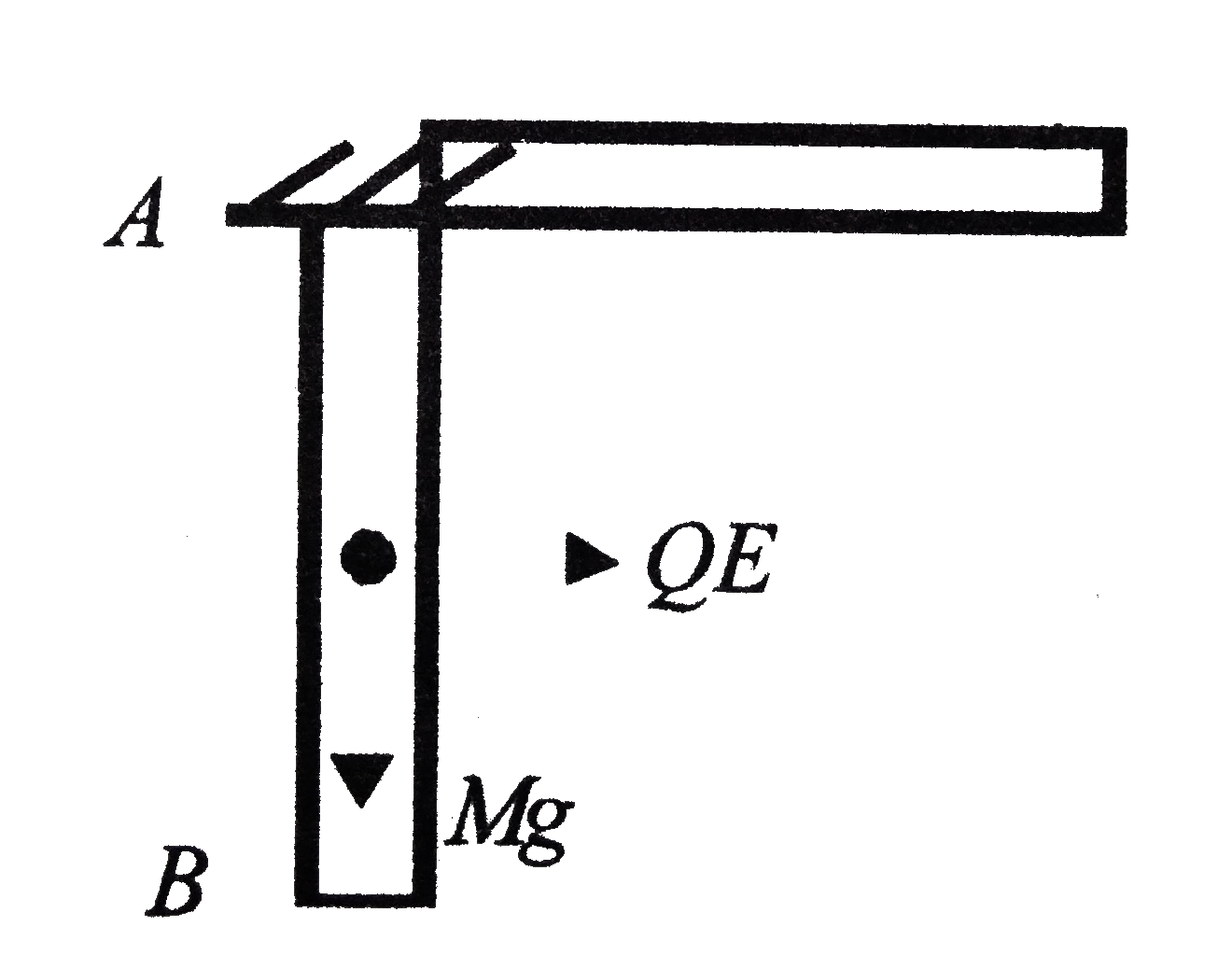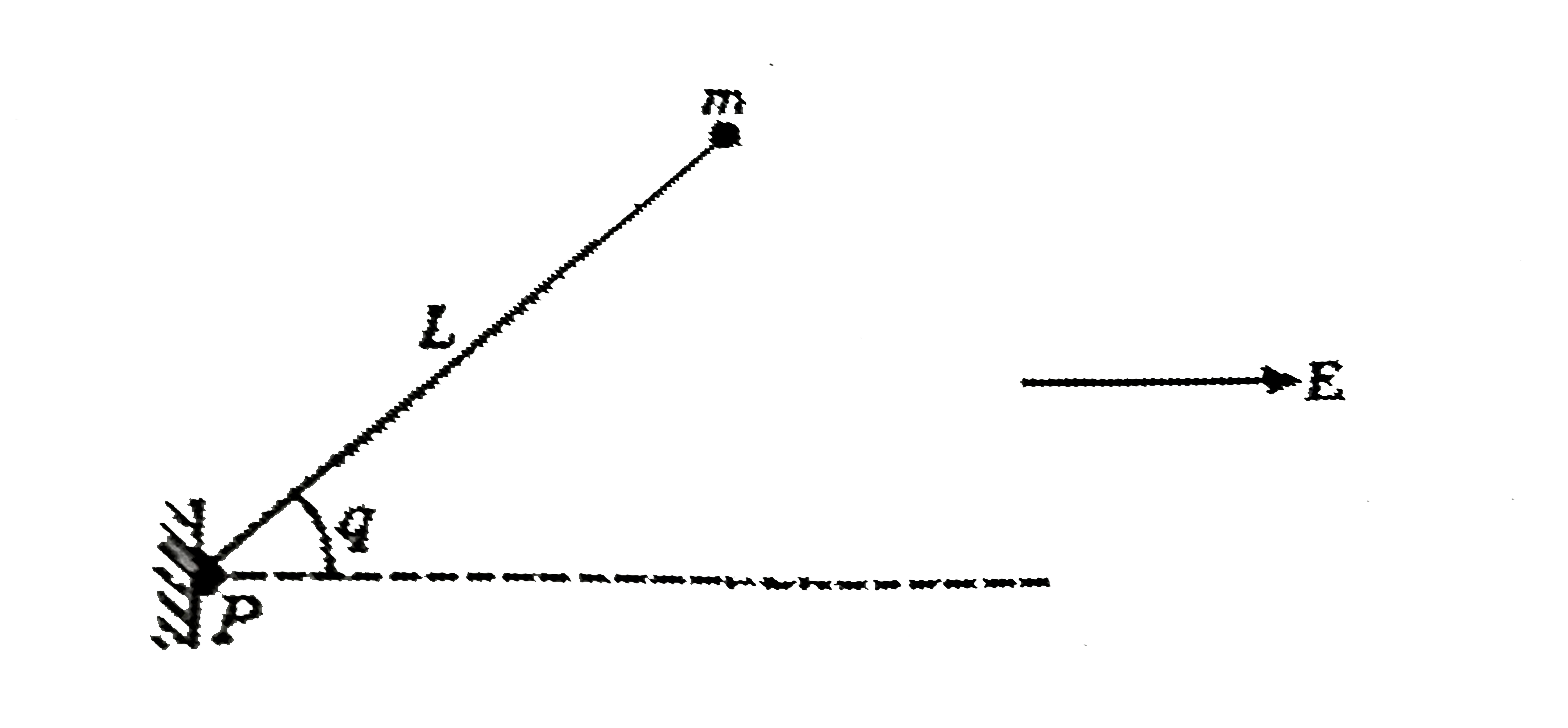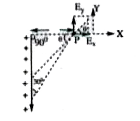A rod AB of length L and mass M is uniformly charged with a charge Q, and it is suspended from end A as shown in fig. The rod can freely rotate about A in the plane of the figure. An electric field E is suddenly switched on in the horizontal direction due to which the rod gets turned by a maximum angle of 90∘. The magnitude of E is equal of nMg/Q. Find the value of n.

The correct Answer is:1
After truning through 90∘ the rod comes at rest momentarily. So there is no change in KE. Net work done by all force should be zero.

QEL2−MgL2=0orE=MgQ.
Topper's Solved these Questions
- BOOK - CENGAGE PHYSICSCHAPTER - COULOMB LAW AND ELECTRIC FIELDEXERCISE - Single Correct Ansewr Type20videos
COULOMB LAW AND ELECTRIC FIELD
- BOOK - CENGAGE PHYSICSCHAPTER - COULOMB LAW AND ELECTRIC FIELDEXERCISE - Multiple Correct Answers Type2videos
COULOMB LAW AND ELECTRIC FIELD
- BOOK - CENGAGE PHYSICSCHAPTER - COULOMB LAW AND ELECTRIC FIELDEXERCISE - Comprehension25videos
COULOMB LAW AND ELECTRIC FIELD
- BOOK - CENGAGE PHYSICSCHAPTER - COMMUNICATION SYSTEMEXERCISE - QUESTION BANK19videos
COMMUNICATION SYSTEM
- BOOK - CENGAGE PHYSICSCHAPTER - Current ElectricityEXERCISE - QUESTION BANK40videos
Current Electricity
Similar Questions
A positively charged insulator is brought near(but does not touch) two metallic sphere that are in contact. The metallic spheres are then separated. The sphere which was initially farthest from the insulator will have:
02:52View SolutionSelect the incorrect statement w.r.t. charges:
04:34View SolutionTwo small identical conducting balls A and B of charges +10μC and +30μC respectively, are kept at a separation of 50 cm. these balls have been connected by a wire for a short time. The final charge on each of the balls A and B will be
05:38View SolutionThe maximum and minimum amplitudes of a modulated wave are 15V and 5V, respectively. Find the amplitude (in volt) of the modulating wave.
07:36View SolutionThe current (in ampere) through a copper wire having cross sectional area 2mm2 Given:
E=8.5×10−3Vm
ρ=1.7×10−8ohmm03:55View SolutionA thin homogeneous rod of mass m and length l is free to rotate in vertical plane about a horizontal axle pivoted at one end of the rod. A small ballof mass m and charge q is attached to the opposite end of this rod. The whole system is positioned in a horizontal electric field of magnitude E=(mg)/(2q) . The rod is released from, shown position from rest. What is the angular acceleration of the rod at the instant of releasing the rod?
View SolutionA thin homogeneous rod of mass m and length l is free to rotate in vertical plane about a horizontal axle pivoted at one end of the rod. A small ballof mass m and charge q is attached to the opposite end of this rod. The whole system is positioned in a horizontal electric field of magnitude E=(mg)/(2q) . The rod is released from, shown position from rest. What is the speed of ball when rod becomes vertical?
07:50View SolutionA thin uniform rod of mass M and length 2L is hinged at its centre O so that it can rotate freely in horizontal plane about the vertical axis through O. at its ends the insulating rod has two point charges 2q and q (see figure). An electrif field E is switched on making and angle theta_(0)=60^(@) with the initial position of the rod. The field is uniform and horizontal. (a) Calculate the maximum angular velocity of the rod during subsequent motion. (b) Find the maximum angular acceleration of the rod.
View SolutionA uniformly charged non conducting rod is suspended vertically at its end. The rod can swing freely in the vertical plane without any friction. The linear charge density on the rod is lamda C//m and it has a uniformly distributed mass of M Length of the rod is L. A uniform horizontal electrif field (E) is switched on in the region. (a). For what value of electric field (call it E_(0) ) the rod just manages to make itself horizontal.? (b). If eletrif field E_(0) is switched on, what is the maximum angular speed acquired by the rod during its motion?
02:19View SolutionA particle of mass m and charge q is attached to a light rod oflength L. The rod cau rotate freely in the plane of paper about the other end, which is hinged at P, the.entire assembly lies in an uniform electric field E acting in the plane of paper ·as shown in the figure-. The rod is released from rest when it makes an angle 9 with the electric field direction. Determine the speed oft he particle when the rod becomes parallel to the electric field:
 06:41View Solution
06:41View SolutionA uniform rod AB of length L and mass m is uniformly charged with a charge Q and it is freely suspended from end A as shown in figure. An electric E is suddenly switched on in the horizontal direction due to which rod get turned by a maximum angle 90∘. The magnitude of E is how many number of times of MgQ
 03:34View Solution
03:34View SolutionThe direction (q) of →E at point p due to uniformly charged rod will be
 03:44View Solution
03:44View SolutionA uniform rod of length l and mass m is given a charge Q and is suspended vertically by means of a hinge at the top end. A horizontal electric field E is switched on, in the direction in which the rod can sway freely. Find the angle made by the rod with the vertical in equilibrium.
02:30View SolutionA charged rod is suspended freely lira horizontal position:- A charged polythene rod when brought near one end of this charged rod gets repelled. Why?
03:10View SolutionFind the electric field at a point P on the perpendicular bisector of a uniformly charged rod. The length of the rod is L, the charge on it is Q and the distance of P from the centre of the rod is a.
05:51View Solution

